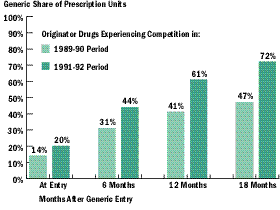 |
|
|
|
| Backgrounders and Facts | |
| More Publications | |
| Search our Database | |
| Industry Data |
![]()
![]()
Just as the price of a textbook is not determined by the cost of the paper of its pages and the cost of surgery has little to do with the price of the surgeon's scalpel, the cost of a medicine is not simply the cost of its ingredients. Like other products that result from research and creativity, medicines are really made of knowledge — knowledge that prevents and cures disease and relieves suffering.
The knowledge needed to discover and develop new medicines does not come cheap. Discovering, developing, testing, and gaining regulatory approval for new medicines is expensive, time consuming and risky.
- Of every 5,000 medicines tested, on average, only 5 are tested in clinical trials and only 1 of those is approved for patient use. Revenues from successful medicines must cover the costs of the "dry holes."
-
The average cost of bringing one new medicine to market is $500 million.
-
It takes an average of 12-15 years to discover and develop a new medicine. Most of that time is spent testing the drug to make sure it is safe.
-
On average, only 3 of every 10 prescription drugs available to treat Americans generate revenues that meet or exceed average R&D costs (Figure 1).
-
Although the cost of developing drugs is soaring, the time that companies have to recoup their investment is shrinking due to stepped-up competition from generic drugs (Figure 2).
-
Companies fund research on future medicines and improvements to existing medicines with revenues from medicines on the market. One out of every five dollars in revenues is poured back into research and development. Currently, pharmaceutical companies are working on more than 1,000 new medicines — for Alzheimer's, stroke, cystic fibrosis, arthritis, and many other diseases. For cancer alone, there are more than 350 medicines in the pipeline.
|
Only Three of Ten Marketed Drugs Produce Revenues that Match or Exceed Average R&D Costs |
 |
| Note: The drug
development cost cited in this chart is after-tax in 1990 dollars
for drugs introduced 1980-1984. Based on a separate analysis by the
Boston Consulting Group, the pre-tax R&D cost for drugs
introduced in 1990 is $500 million.
Source: Grabowski, H., and Vernon, J.,"Returns to R&D on New Drug Introductions in the 1980s," Journal of Health Economics, Vol. 13, 1994. |
|
Newer Originator Drugs Experience More Rapid Grown of Generic Competition |
 |
| Source: Grabowski, H., and Vernon, J., "Longer Patents for Increased Generic Competition: The Waxman-Hatch Act After One Decade," working paper, June 1995. |
| to the next page of Questions about Your Medicines | |
| to the first page of Questions about Your Medicines |
Privacy
Policy • Members
Site • Contact
Us • Site
Credits • Site Map • Employment
Pharmaceutical Research and Manufacturers of America
1100 Fifteenth
Street, NW Washington, DC 20005
+1.202.835.3400
